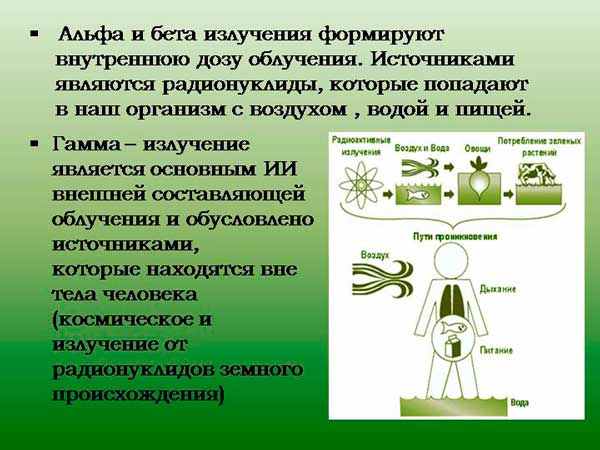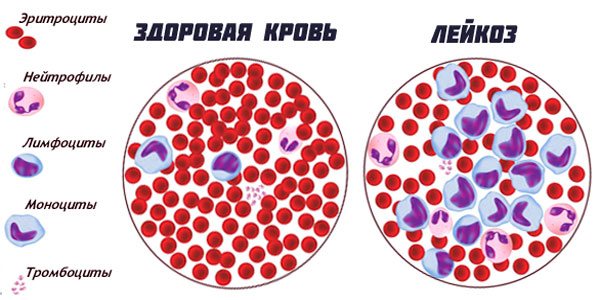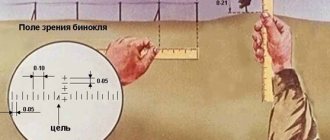Types of radiation
Initially, radiation affects the body from the outside. It comes from natural radioactive elements that are found in the earth, and also enters the planet from space. Also, external radiation comes in microdoses from building materials and medical X-ray machines. Large doses of radiation can be found in nuclear power plants, special physics laboratories and uranium mines. Nuclear weapons testing sites and radiation waste disposal sites are also extremely dangerous.
To a certain extent, our skin, clothing and even homes protect from the above radiation sources. But the main danger of radiation is that exposure can be not only external, but also internal.
Radioactive elements can penetrate air and water, through cuts in the skin and even through body tissue. In this case, the radiation source lasts much longer - until it is removed from the human body. You can’t protect yourself from it with a lead plate and it’s impossible to get away, which makes the situation even more dangerous.
Effect of radiation rays
Unfortunately, it is simply impossible to protect yourself and your family from radiation. Radiation rays can kill, this may be a consequence of an overdose. Even the rays of the sun contain radioactive elements that penetrate the human body. Everything that covers the body (clothes, shoes) provides some protection from harmful rays, but such protection will not help much.
On planet Earth, you can get a dose of radiation during ordinary walks in the park. But it is especially dangerous to be near test sites where nuclear weapons were previously tested. Without good protection, you cannot visit laboratories, burial sites and other places where the level of radiation may be too high.
The effect of radiation on the human body occurs completely unnoticed. Radioactive elements can enter through the respiratory tract and even through a small cut, but it is very difficult to get rid of them, since these particles leave the body very slowly. If the dose is too large, you will have to cleanse the body. There are only 2 types of radiation: external and internal. Our skin and all clothing protect us from external radiation, but we have no protection from internal radiation. This means that we are too vulnerable to harmful rays.
Even more than 70 years after the nuclear bombing of Hiroshima and Nagasaki, radiation makes its presence felt. People live there, but they have serious health problems. Even many decades after the nuclear bombing, the ground and air in these cities are still saturated with radioactive substances.
The people of Hiroshima and Nagasaki have a much shorter life expectancy than us, and their children are born unhealthy. Their body has already undergone mutation, everything has even gone down to DNA. They and their children will not have a healthy generation for a very long time.
Children are born with six fingers and other mutations and their lives are extremely different from ours. It is impossible to grow normal vegetables or fruits there, since the soil is saturated with radioactive elements. This situation will continue until the earth and air are completely cleared, which means that the negative impact of radiation on the human body will continue for several generations.
Read also Cell towers: harm and danger of radiation, protective measures
Radiation dosage
In order to determine the radiation power and the degree of impact of radiation on living organisms, several measurement scales were invented. First of all, the power of the radiation source in Grays and Rads is measured. Everything is quite simple here. 1 Gy=100R. This is how exposure levels are determined using a Geiger counter. The X-ray scale is also used.
But you should not assume that these readings reliably indicate the degree of health hazard. It is not enough to know the radiation power. The effect of radiation on the human body also varies depending on the type of radiation. There are 3 of them in total:
- Alpha. These are heavy radioactive particles - neutrons and protons, which cause the greatest harm to humans. But they have little penetrating power and are not able to penetrate even the upper layers of the skin. But if there are wounds or particles in the air,
- Beta. These are radioactive electrons. Their penetration capacity is 2 cm of skin.
- Gamma. These are photons. They freely penetrate the human body, and protection is only possible with the help of lead or a thick layer of concrete.

Irradiation leads to the formation of free radicals in body cells, which begin to destroy surrounding substances. But, taking into account the uniqueness of each organism and the uneven sensitivity of organs to the effects of radiation on humans, scientists had to introduce the concept of an equivalent dose. To determine how dangerous radiation is in a particular dose, the radiation power in Rads, Roentgens and Grays is multiplied by the quality factor.
For Alpha radiation it is equal to 20, and for Beta and Gamma it is 1. X-rays also have a coefficient of 1. The result obtained is measured in Rem and Sievert. With a coefficient equal to one, 1 Rem is equal to one Rad or Roentgen, and 1 Sievert is equal to one Gray or 100 Rem.
To determine the degree of exposure of an equivalent dose to the human body, it was necessary to introduce another risk coefficient. It is different for each organ, depending on how radiation affects individual tissues of the body. For the organism as a whole it is equal to one. Thanks to this, it was possible to create a scale of the danger of radiation and its impact on humans after a single exposure:
- 100 Sievert. This is a quick death. After a few hours, or at best days, the body’s nervous system stops functioning.
- 10-50 is a lethal dose, as a result of which a person will die from numerous internal hemorrhages after several weeks of suffering.
- 4-5 Sievert – -mortality rate is about 50%. Due to damage to the bone marrow and disruption of the hematopoietic process, the body dies after a couple of months or less.
- 1 sievert. It is from this dose that radiation sickness begins.
- 0.75 Sievert. Short-term changes in the composition of the blood.
- 0.5 – this dose is considered sufficient to cause the development of cancer. But there are usually no other symptoms.
- 0.3 Sievert. This is the power of the device when taking an X-ray of the stomach.
- 0.2 Sievert. This is the safe level of radiation allowed when working with radioactive materials.
- 0.1 – with a given radiation background, uranium is mined.
- 0.05 Sievert. Norm of background radiation from medical equipment.
- 0.005 Sievert. Permissible radiation level near nuclear power plants. This is also the annual exposure limit for the civilian population.
Somatic effects of radiation
In the first case, we can talk about radiation sickness, when the consequences of radiation are faced directly by the organism that received it.
Radiation sickness occurs quite quickly after exposure to a high dose of radionuclides and it is impossible not to notice its signs.
Most often it leads to death or severe disability. This is a very dangerous disease that occurs when exposed to large amounts of radiation at once. In this case, it is much easier to prevent it than to cure it.
Consequences of radiation exposure
The dangerous effect of radiation on the human body is caused by the effect of free radicals. They are formed at the chemical level due to exposure to radiation and primarily affect rapidly dividing cells. Accordingly, the hematopoietic organs and reproductive system suffer to a greater extent from radiation.
But the radiation effects of human exposure are not limited to this. In the case of delicate tissues of mucous and nerve cells, their destruction occurs. Because of this, various mental disorders can develop.
Often, due to the effect of radiation on the human body, vision suffers. With a large dose of radiation, blindness can occur due to radiation cataracts.
Other body tissues undergo qualitative changes, which is no less dangerous. It is because of this that the risk of cancer increases many times over. Firstly, the structure of tissues changes. And secondly, free radicals damage the DNA molecule. Due to this, cell mutations develop, which leads to cancer and tumors in various organs of the body.
The most dangerous thing is that these changes can persist in descendants due to damage to the genetic material of the germ cells. On the other hand, the opposite effect of radiation on humans is possible – infertility. Also, in all cases without exception, radiation exposure leads to rapid deterioration of cells, which accelerates the aging of the body.
Mutations
The plot of many science fiction stories begins with how radiation leads to mutation in a person or animal. Typically, the mutagenic factor gives the main character various superpowers. In reality, radiation affects a little differently - first of all, the genetic consequences of radiation affect future generations.
Due to disturbances in the DNA molecule chain caused by free radicals, the fetus may develop various abnormalities associated with problems of internal organs, external deformities or mental disorders. Moreover, this violation may extend to future generations.
The DNA molecule is involved not only in human reproduction. Each cell of the body divides according to the program laid down in the genes. If this information is damaged, cells begin to divide incorrectly. This leads to the formation of tumors. It is usually contained by the immune system, which tries to limit the damaged area of tissue, and ideally get rid of it. But due to immunosuppression caused by radiation, mutations can spread uncontrollably. Because of this, tumors begin to metastasize, turning into cancer, or grow and put pressure on internal organs, such as the brain.
Leukemia and other types of cancer
Due to the fact that the effect of radiation on human health primarily affects the hematopoietic organs and circulatory system, the most common consequence of radiation sickness is leukemia. It is also called “blood cancer”. Its manifestations affect the entire body:
- A person loses weight, and there is no appetite. It is constantly accompanied by muscle weakness and chronic fatigue.
- Joint pain appears and they begin to react more strongly to environmental conditions.
- Lymph nodes become inflamed.
- The liver and spleen enlarge.
- Breathing becomes difficult.
- Purple rashes appear on the skin. The person sweats frequently and profusely, and bleeding may occur.
- Immunodeficiency appears. Infections freely penetrate the body, which often causes the temperature to rise.
Before the events in Hiroshima and Nagasaki, doctors did not consider leukemia to be a radiation disease. But 109 thousand Japanese people examined confirmed the connection between radiation and cancer. It also revealed the likelihood of damage to certain organs. Leukemia came first.

Then the radiation effects of human exposure most often lead to:
- Mammary cancer. Every hundredth woman who survives severe radiation exposure is affected.
- Thyroid cancer. It also affects 1% of those exposed.
- Lungs' cancer. This variety manifests itself most strongly in irradiated miners of uranium mines.
Fortunately, modern medicine can easily cope with cancer in the early stages, if the effect of radiation on human health was short-term and quite weak.
What affects the effects of radiation
The effects of radiation on living organisms vary greatly depending on the strength and type of radiation: alpha, beta or gamma. Depending on this, the same dose of radiation can be practically safe or lead to sudden death.
It is also important to understand that the effects of radiation on the human body are rarely simultaneous. Getting a dose of 0.5 Sievert at a time is dangerous, and 5-6 is fatal. But by taking several x-rays of 0.3 Sievert over a certain period of time, a person allows the body to cleanse itself. Therefore, the negative consequences of radiation exposure simply do not appear, since with a total dose of several Sieverts, only a small part of the radiation will affect the body at a time.
In addition, the various effects of radiation on humans strongly depend on the individual characteristics of the organism. A healthy body resists the destructive effects of radiation longer. But the best way to ensure the safety of radiation for humans is to have as little contact with radiation as possible to minimize damage.











